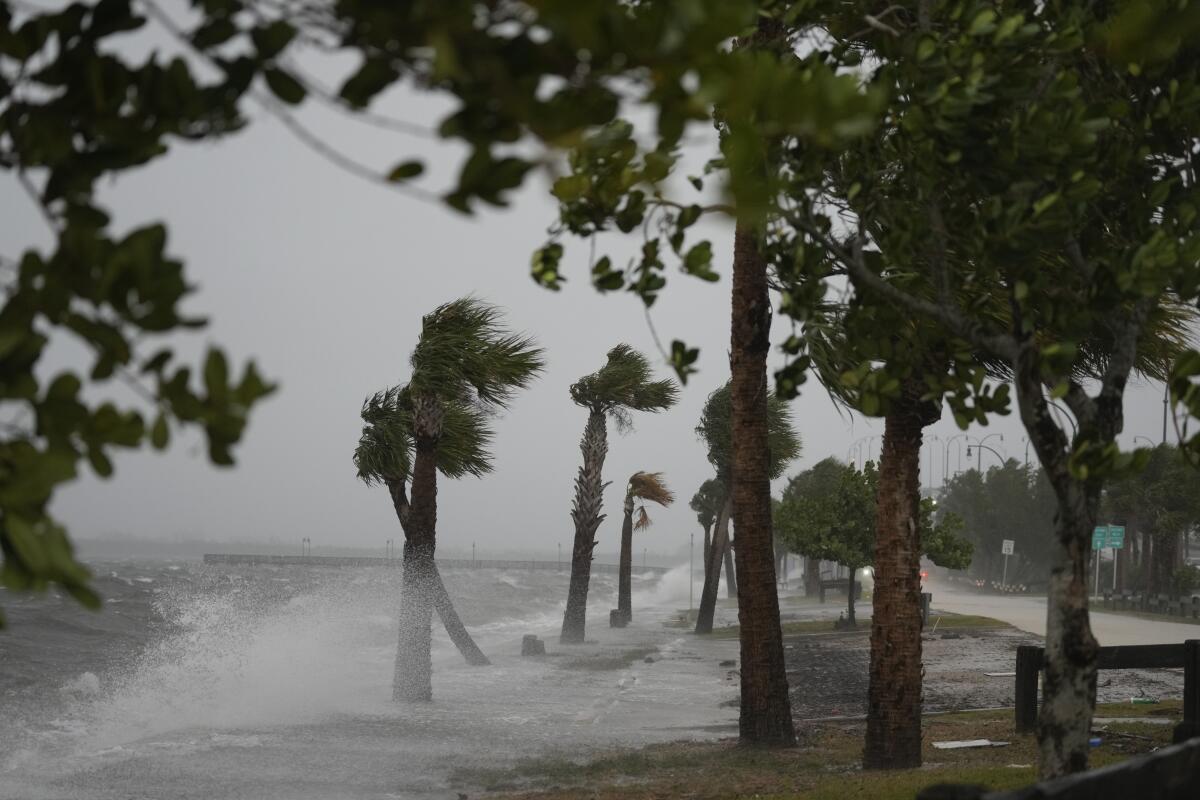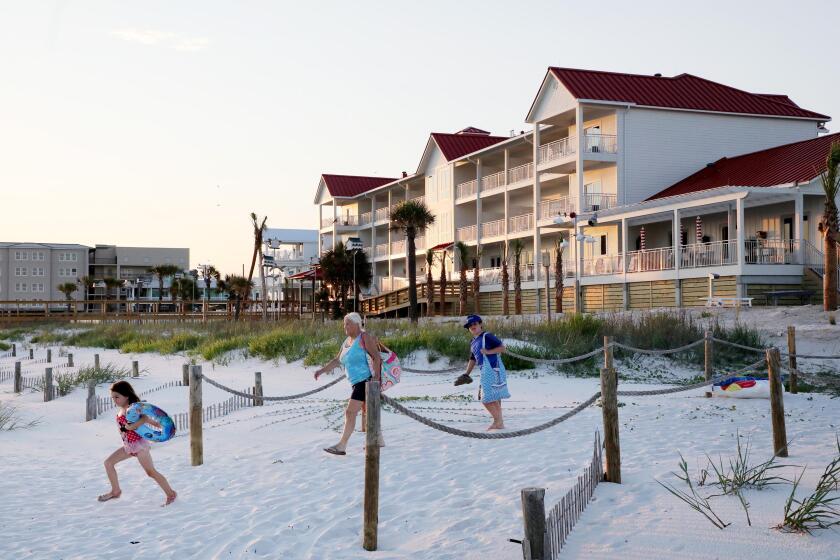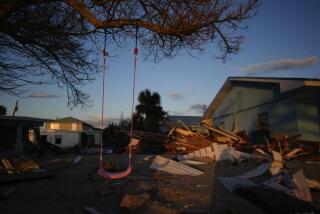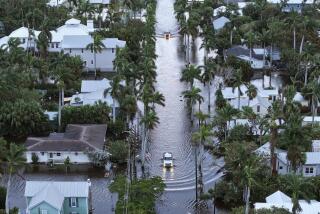Tropical Storm Nicole sends beachfront homes into ocean

WILBUR-BY-THE-SEA, Fla. — Tropical Storm Nicole sent Florida homes toppling into the Atlantic Ocean on Thursday and threatened a row of high-rise condominiums in areas where Hurricane Ian washed away beaches and destroyed seawalls only weeks ago.
The storm, which has caused at least two deaths, was the first November hurricane to make landfall in Florida in 37 years, and only the third on record. It delivered another devastating blow just weeks after Ian came ashore on the Gulf Coast, killing more than 130 people and destroying thousands of homes.
Although Nicole’s winds died down after it made landfall as a Category 1 hurricane around 3 a.m. Thursday near Vero Beach, its storm surge slammed into the shoreline in the neighboring barrier island communities of Wilbur-by-the-Sea and Daytona Beach Shores, sending homes crashing into the ocean.
Officials in Volusia County, which is northeast of Orlando, said Thursday evening that building inspectors had declared 24 hotels and condo buildings in Daytona Beach Shores and New Smyrna Beach to be unsafe and had ordered their evacuations. At least 25 single-family homes in Wilbur-by-the-Sea have been declared structurally unsafe by building inspectors and also were evacuated, county officials said.
“Structural damage along our coastline is unprecedented. We’ve never experienced anything like this before,” county manager George Recktenwald said at a news conference earlier, noting that it’s not clear when it will be safe for evacuated residents to return.
The county’s sheriff, Mike Chitwood, said in a social media post that multiple coastal homes in Wilbur-by-the-Sea had collapsed and that several other properties were at “imminent risk.” He said most bridges to the beachside properties had been closed to all but essential personnel and a curfew was in effect.
Krista Dowling Goodrich, who manages 130 rental homes in Wilbur-By-The-Sea and Daytona Beach Shores as director of sales and marketing at Salty Dog Vacations, witnessed backyards collapsing into the ocean just ahead of the storm.
In the aftermath, the backs of about seven colorful houses along Highway A1A had disappeared. Water lapped below the foundation of one modern house that was missing two bedrooms and much of its living room. On a partially collapsed wall, decorations spelled out “Blessed” and “Grateful.” Goodrich burst into tears at the sight.
“Half of the house is gone, but we did manage to get out family photos yesterday,” she said. “It is overwhelming when you see this. These are hardworking people who got to this point in their lives, and now they lose it all.”
Four years after a Category 5 hurricane hit Mexico Beach, the small Florida seaside town is building back. Is it becoming a preserve of the wealthy?
In Daytona Beach Shores, where bathrooms attached to the city’s Beach Safety Ocean Rescue building had collapsed, officials deemed several multistory buildings unsafe and went door-to-door telling people to grab their possessions and leave.
“These were the tall high-rises. So the people who wouldn’t leave, they were physically forcing them out, because it’s not safe,” Goodrich said.
The homeowners association at the Marbella condominiums in Daytona Beach Shores had just spent $240,000 to temporarily rebuild the seawall Ian destroyed in September, said Connie Hale Gellner, whose family owns a unit there. Live video from the building’s cameras showed Nicole’s storm surge washing the seawall away.
“We knew it wasn’t meant to stop a hurricane; it was only meant to stop the erosion,” Gellner said, adding that after Nicole, the building’s pool deck was “basically in the ocean.”
“The problem is that we have no more beach,” she said. “So even if we wanted to rebuild, they’ll probably condemn the building because the water is just splashing up against the building.”
Nicole was sprawling, hitting nearly the entire storm-weary state of Florida and reaching into Georgia and the Carolinas before dawn Thursday. Tropical-storm-force winds extended as far as 450 miles from Nicole’s center in some directions as it turned northward over central Florida.
Although Nicole’s winds did minimal damage, its storm surge was especially destructive because seas are rising as the planet’s ice melts due to climate change, said Princeton University climate scientist Michael Oppenheimer. That means higher coastal flooding that flows deeper inland, and what used to be once-in-a-century events will happen almost yearly in some places, he said.
“It’s going to happen elsewhere,” Oppenheimer added. “It’s going to happen all across the world.’’
A man and a woman were killed when they touched downed power lines in the Orlando area, the Orange County Sheriff’s Office said.
Nicole also caused flooding well inland. Parts of the St. Johns River were at or above flood stage and some rivers in the Tampa Bay area were also nearing flood levels, according to the National Weather Service.
Although Nicole made landfall near Vero Beach, it caused no significant damage there, officials said. Part of a fishing pier washed away in Lauderdale-by-the-Sea, but the brunt of the storm hit north of its center. By 1 p.m. Thursday, Nicole’s maximum sustained winds were down to 45 mph as it moved toward Tallahassee.
The rare November hurricane could dump as much as 6 inches of rain over the Blue Ridge Mountains by Friday, the hurricane center said. Flash and urban flooding will be possible as the rain spreads into the eastern Ohio Valley, Mid-Atlantic and New England through Saturday.
Puerto Rico’s agriculture minister says Hurricane Fiona destroyed $159 million worth of crops when it hit a month ago, decimating fields of plantains, bananas and more.
Nicole was the first hurricane to hit the Bahamas since Hurricane Dorian, a Category 5 storm that devastated the archipelago in 2019. For storm-weary Floridians, it is the first November hurricane to hit their shores since 1985, and only the third since recordkeeping began in 1853.
All 67 Florida counties were under a state of emergency. President Biden also approved an emergency declaration for the Seminole Tribe of Florida, ordering federal help for the Indigenous nation, many of whose members live on six reservations around the state.
The skeletal remains of six people believed to be from a Native American burial ground were unearthed by Nicole’s wind and waves on a Hutchinson Island beach, according to the sheriff’s office in Martin County, which is about 160 miles south of Volusia County.
“Detectives are working diligently to preserve and carefully remove the remains that are exposed with the utmost care and respect,” the office said in a news release. The remains will be taken to a medical examiner and then to the state Bureau of Archaeological Research.
At a news conference in Tallahassee on Thursday, Gov. Ron DeSantis said about 333,000 customers — almost 3% of those in the state — were without power at midmorning. He said that 17,000 electrical line workers were ready to begin restoring power, and that assets including rescue boats and vehicles would be deployed as needed.
Schools in almost two dozen districts closed, and 15 shelters opened along Florida’s east coast, the governor said.
Parts of Florida are still recovering from Hurricane Ian, which struck as a Category 4 storm. Ian destroyed homes and damaged crops, including orange groves, across the state and sent storm surges of up to 13 feet onshore, causing widespread destruction.
Frisaro reported from Fort Lauderdale. Associated Press staff members Terry Spencer in Vero Beach, Curt Anderson in St. Petersburg, David Fischer in Miami and Seth Borenstein in Sharm el-Sheikh, Egypt, contributed to this report.
More to Read
Sign up for Essential California
The most important California stories and recommendations in your inbox every morning.
You may occasionally receive promotional content from the Los Angeles Times.












